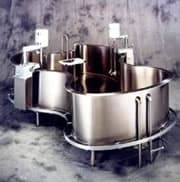Water Use in Hydrotherapy Tanks
Hydrotherapy
Hydrotherapy involves the use of water for soothing pains and treating certain medical conditions. Hydrotherapy equipment includes pools, whirlpools, whirlpool spas, hot tubs, and physiotherapy tanks. Patients with medical conditions, such as burns, septic ulcers, lesions, amputations, and arthritis, can benefit from the effects of sitting in warm water. For the health and safety of patients, it is vital to ensure that the water that is used in hydrotherapy is safe and clean. Many of these patients have compromised immune systems due to current infections and are highly susceptible to new infections from contaminated water in hydrotherapy pools. Potential routes of infection caused by contaminated water include accidental ingestion of the water, breathing sprays and aerosols from the water, and allowing wounds to come in direct contact with the water.
Infection control for hydrotherapy tanks, pools, or birthing tanks presents unique challenges because naturally-occurring microbes, that may not be dangerous for a healthy individual, are always present in the water during treatments. According to CDC’s Division of Healthcare Quality Promotion and the Healthcare Infection Control Practices Advisory Committee (HICPAC), the use of hydrotherapy for patients with wounds, burns, or other types of non-intact skin conditions should be considered on a case-by-case basis. Health-care providers should always consider the availability of alternative aseptic techniques for wound management, as well as a risk-benefit analysis of using traditional hydrotherapy. If hydrotherapy is used, facilities should maintain strict cleaning and disinfection practices in accordance with the manufacturer’s instructions.
For more information on hydrotherapy tanks and pools, visit Guidelines for Environmental Infection Control in Health-Care Facilities [PDF – 2.31 MB] (240 pages) from CDC and the Healthcare Infection Control Practices Advisory Committee (HICPAC).
Guidelines for Environmental Infection Control in Health Care Facilities-Hydrotherapy Tanks and Pools
Recommendations of CDC’s Healthcare Associated Infections Program.
[This information was taken directly from page 20 of the MMWR report titled “Guidelines for Environmental Infection Control in Health-Care Facilities” pdf icon[PDF – 48 pages]]

- Drain and clean hydrotherapy equipment (for example, Hubbard tanks, tubs, whirlpools, whirlpool spas, or birthing tanks) after each patient’s use, and disinfect equipment surfaces and components by using an EPA-registered product in accordance with the manufacturer’s instructions. Category II
- In the absence of an EPA-registered product for water treatment, add sodium hypochlorite to the water:
- Maintain a 15-ppm chlorine residual in the water of small hydrotherapy tanks, Hubbard tanks, and tubs. Category II
- Maintain a 2-5-ppm chlorine residual in the water of whirlpools and whirlpool spas. Category II
- If the pH of the municipal water is in the basic range (for example, when chloramine is used as the primary drinking water disinfectant in the community), consult the facility engineer regarding the possible need to adjust the pH of the water to a more acidic level before disinfection, to enhance the biocidal activity of the chlorine. Category II
- Clean and disinfect hydrotherapy equipment after using tub liners. Category II
- Clean and disinfect inflatable tubs unless they are single-use equipment. Category II
- No recommendation is offered regarding the use of antiseptic chemicals (for example, chloramine-T) in the water during hydrotherapy sessions. Unresolved issue
- Conduct a risk assessment of patients before their use of large hydrotherapy pools, deferring patients with draining wounds or fecal incontinence from pool use until their condition resolves. Category II
- For large hydrotherapy pools, use pH and chlorine residual levels appropriate for an indoor pool as pro-vided by local and state health agencies. Category IC (States)
- No recommendation is offered regarding the use in health-care settings of whirlpool or spa equipment manufactured for home or recreational use. Unresolved issue
Rating Categories
Recommendations are rated according to the following categories:
- Category IA
- Strongly recommended for implementation and strongly supported by well-designed experimental, clinical, or epidemiologic studies.
- Category IB
- Strongly recommended for implementation and supported by certain experimental, clinical, or epidemiologic studies and a strong theoretic rationale.
- Category IC
- Required by state or federal regulation, or representing an established association standard. (Note: Abbreviations for governing agencies and regulatory citations are listed where appropriate. Recommendations from regulations adopted at state levels are also noted. Recommendations from AIA guidelines cite the appropriate sections of the standards.)
- Category II
- Suggested for implementation and supported by suggestive clinical or epidemiologic studies, or a theoretic rationale.
- Unresolved issue
- No recommendation is offered. No consensus or insufficient evidence exists regarding efficacy.